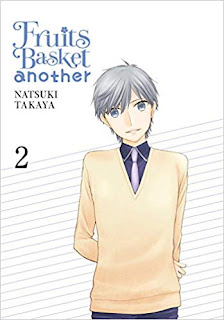Kiss & White Lily volume 6 by Canno (published in the US by Yen Press) centers around my third favorite couple (Izumi and "Forehead-senpai" Chiharu) and their intersection with a group of three girls, Amane, Ryou, and Nina. Amane's family owns a flower shop and the girls of the school are giving flowers to each other with a ribbon attached symbolizing friendship, apology, etc.., and a red one for love. Through a series of manga-typical confusions this leads to a mistaken understanding by Chiharu which causes Izumi to make a grand gesture of reconciliation.
Hoshino-senpai, who graduated, also comes back to visit prompting complex feelings in Chiharu and a slight reassessment of her feelings for Izumi. This leads to a really sweet that moment I won't give away, but let's say that it's clear that Izumi and Chiharu's relationship is moving ahead in a mutually honest way.
The bulk of the remaining chapters focuse on Amane and her relationship with Ryou and Nina. Amane and Nina room together and Nina feels very strongly about Amane. However, between Amane's sort-of confession to Izumi earlier, her relationship with Nina, and her pursuit of befriending (and more?) Ryou, it is clear that Amane has a different perspective on relationships than many of the other couples we have met.
Amane quite clearly professes that she believes a person can be in love and actively love (ie be in relationships with) many people simultaneously. This presents some serious conflict with Nina, who unfortunately acts in ways that don't seem very believable. However, the resolution at the end of the volume has a somewhat odd-feeling twist that doesn't yet seem authentic. I'm almost, but not quite, interested in what Canno might do with this love(?) triangle in future volumes.
So, the Izumi and Chiharu stuff was cute and okay, but they still aren't given the depth of character development and life stories we have from Yurine and Shiramine or second-favorite couple Moe and Mizuki. There were a couple of good moments, especially where we get insight into Chiharu's feelings for Izumi.
However, I'm really torn about the Amane character. In some senses she provides a very different perspective to look at relationships. This could add some freshness to the series. However, I'm concerned that it will not necessarily be dealt with at the level of honesty that we deserve in an exploration of someone who is polyamorous and the impact of that when trying to find romance with individuals who prefer monogamy. I worry that it will be handled either too simply, forgotten entirely, or some magic-wand-fixes-it-all sort of stuff will happen that could even invalidate Amane as a person or a sensitively handled bit of representation for the polyamorous community.
All that being said, I still wasn't really into those three characters. Six volumes in, I just don't need even more people added. I'd much prefer depth with the existing couples than to keep adding more. I liked how their story intertwined with Izumi and Chiharu's. However, I wasn't grabbed by the new characters, who we know nothing about, and don't have any depth, so I would have been fine with a totally different story in this volume. Izumi and Chiharu's setups could have come about through other means and the results would have been similar.
The art continues to be fine. Overall good depth and shading. Screentones are used for shading more so than expressive moments. The art is still a bit moe for me, but it could be worse. Characters are clearly defined and visually identifiable (although I'd like a listing of them all in each volume - but thankfully the main ones for each volume are identified in accompanying 1-page drawings). The pacing is fairly clear. So no real complaints, and no real thrills, about the art.
I'm giving this volume a 6/10 because it is fine, it's got some romance, hi-jinks, emotions, a kiss, but with our top two most interesting couples not in the volume, I just didn't care about it very much. Oh well, on to volume 7 and then I'll be caught up to the upcoming new releases.
⚘✩🚺
















